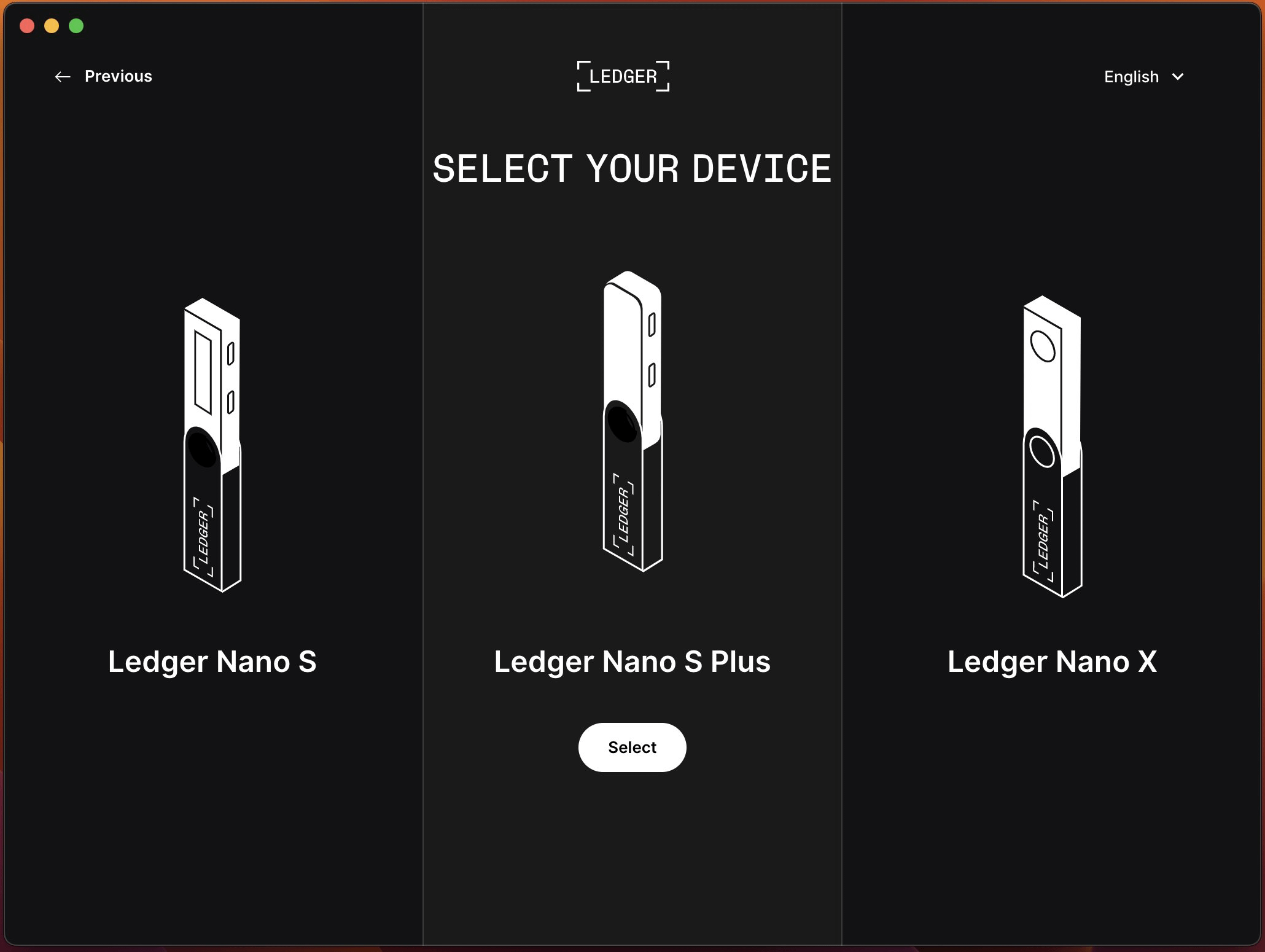Staking has become one of the most popular ways to earn passive income in the cryptocurrency world. With the rise of decentralized finance (DeFi) and the increasing interest in Proof-of-Stake (PoS) coins, more and more people are looking for ways to put their idle coins to work and earn rewards.
If you are a Ledger wallet user, you are in luck. Ledger wallets are not just for storing and managing your cryptocurrencies, they can also be used to stake coins. This comprehensive guide will show you how to stake your coins directly from your Ledger device, so you can start earning rewards and making your assets work for you.
First, you need to make sure you have the necessary coins to stake. Bitcoin and other Proof-of-Work (PoW) coins cannot be staked, so you will need to look for coins that are built on PoS or other staking protocols. Once you have these coins, you can install the corresponding wallet app on your Ledger device.
Next, you need to set up your Ledger device to interact with the staking network. This involves updating your Ledger firmware to the latest version, installing the necessary apps on your device, and configuring the staking settings. Once your Ledger device is ready, you can start staking your coins and earning rewards.
Staking works by locking up a certain amount of coins as a security deposit to participate in the network’s consensus mechanism. In return, you will receive staking rewards, which are usually paid out in the form of additional coins. The amount of rewards you receive will depend on the amount of coins you stake and the duration of your stake.
In conclusion, staking coins on your Ledger wallet is a great way to earn passive income and make your assets work for you. By following this comprehensive guide, you can set up your Ledger device to stake coins and start earning rewards. Just make sure to do your research and choose the right coins to stake, as not all coins are created equal when it comes to staking.
- Proof of Stake
- Different Ways to Generate Revenue by Staking
- Cryptos to Stake with Ledger
- Proof of Work
- Why Stake with Ledger
- Claiming
- Running Validators
- How to Stake Coins with Ledger + External Wallets
- Difference between PoW and PoS
- Staking on Ledger – How to Stake Coins with Ledger Live
- Delegating or Nominating
- Frequently Asked Questions:
- What is a Ledger Wallet?
- What is coin staking?
- Why would I stake my coins on a Ledger Wallet?
- How do I stake coins on a Ledger Wallet?
- Are there any fees associated with staking coins on a Ledger Wallet?
- Can I unstake my coins at any time?
- Video:
- How To Send Crypto TO Ledger Hardware Wallets (2022): Store Crypto Safely
- Staking Ethereum 2.0 on P2P.org Using a Ledger Wallet: Your Easy Guide
- How to stake Polygon MATIC through your Ledger device
Proof of Stake
Proof of Stake (PoS) is a consensus mechanism used in blockchain networks to achieve distributed consensus and secure transactions without the need for mining. Unlike Proof of Work (PoW), which relies on miners solving complex mathematical puzzles, PoS relies on users holding and “staking” their coins to validate and secure transactions.
When you stake coins, you essentially lock them in a wallet or a device, so they are not available for spending. In return for staking, you have the opportunity to earn additional coins as a reward for helping to secure the network.
The process of staking varies depending on the cryptocurrency and the wallet or staking platform you are using. However, the basic concept is the same:
- First, you need to have a compatible device or wallet that supports staking. Ledger Wallet is one such device that supports staking for a variety of cryptocurrencies.
- Next, you need to start the staking process by selecting the coins you want to stake and sending them to a staking address provided by your wallet or staking platform.
- Once your coins are staked, they are used to validate transactions and secure the network. The more coins you stake, the higher the chances of being selected as a validator.
- As a reward for staking, you will receive additional coins. The amount of rewards you earn depends on factors such as the amount of coins staked, the duration of staking, and the overall network participation.
- You can choose to keep staking your rewards or withdraw them to your wallet for further use.
It’s important to note that not all cryptocurrencies support staking, and not all wallets or staking platforms support staking for all cryptocurrencies. However, major cryptocurrencies like Ethereum, Cardano, and Tezos have established staking mechanisms, and wallets like Ledger Live support staking for most of these cryptocurrencies.
Staking can be a profitable way to earn passive income with your cryptocurrencies while helping to secure the network. However, it does require you to keep your device or wallet running and connected to the internet for the staking process to work effectively. Additionally, it’s important to do thorough research and understand the risks involved before staking your coins.
Different Ways to Generate Revenue by Staking

Staking, a process that involves actively participating in the validation of transactions, offers various avenues for generating revenue. Below are some different ways in which you can generate revenue by staking:
- Running a Node: By running a node, you can actively participate in the network validation process and earn rewards. Nodes validate transactions and secure the network, and in return, node operators receive staking rewards.
- Using Staking Platforms: Many staking platforms allow users to stake their coins and earn rewards without having to run a node. These platforms handle the technical aspects of staking, making it more accessible to a wider audience.
- Staking in Wallets: Some wallets offer built-in staking features that allow users to stake their coins directly from their wallets. This eliminates the need to move coins to external platforms or exchanges.
- Staking Pools: Staking pools are a collective group of stakers who combine their resources to increase their chances of earning rewards. By pooling together their staking resources, participants can collectively stake a larger amount, which gives them a higher chance of earning rewards.
- Delegated Staking: In delegated staking, users delegate their coins to a chosen validator or node operator, who then takes care of the staking process on their behalf. Users still earn rewards, but don’t need to run or maintain their own node.
Regardless of the method you choose, staking offers a way to generate passive income by putting your coins to work. With energy-efficient blockchains like Bitcoin leading the way, staking is becoming an increasingly popular way to earn additional income in the cryptocurrency space. Start exploring the various staking options available and find the most suitable method for your needs and preferences.
Cryptos to Stake with Ledger
When it comes to staking cryptocurrencies, Ledger devices support a wide range of options. Here are some of the most popular cryptocurrencies that you can stake using your Ledger device:
- Bitcoin (BTC): Staking Bitcoin is not energy-intensive since it does not require running a full node. Instead, you can delegate your BTC to a trusted staking pool to earn rewards.
- Ethereum (ETH): While Ethereum 2.0 is still in development, Ledger Live provides a convenient way to participate in staking by allowing you to stake your ETH directly from your Ledger device.
- Cardano (ADA): Ledger Live also supports staking ADA on the Cardano network. Staking ADA helps secure the network and earn rewards in the form of additional ADA.
- Polkadot (DOT): Polkadot’s proof-of-stake consensus mechanism allows DOT holders to stake their tokens and participate in the network’s security and governance.
- Tezos (XTZ): With Ledger, you can easily delegate your XTZ to a baker and earn rewards for securing the Tezos blockchain.
- Cosmos (ATOM): By staking ATOM, you become an active participant in the Cosmos network and earn staking rewards.
These are just a few examples of the cryptocurrencies that you can stake using your Ledger device. Besides these, there are many other options available, depending on the network and the staking requirements. Make sure to check the Ledger Live app for an up-to-date list of supported cryptocurrencies and start staking to receive rewards!
Proof of Work
In the world of cryptocurrencies, Proof of Work (PoW) is a consensus algorithm used to secure and validate transactions on a blockchain network. It is currently the most widely used consensus algorithm and is primarily utilized by Bitcoin and many other cryptocurrencies.
The concept of Proof of Work involves miners competing to solve complex mathematical puzzles in order to validate transactions and add them to the blockchain. Miners need powerful computing devices to perform these calculations, consuming a significant amount of energy in the process.
When a transaction is initiated on a PoW blockchain, it is broadcasted to all the nodes in the network. Miners, who are running specialized hardware devices, start competing to solve the mathematical puzzle associated with the transaction. The first miner to solve the puzzle adds the transaction to a block, receives a reward (usually in the form of newly minted coins), and broadcasts the solution to the network.
The other nodes in the network then verify the solution provided by the winning miner and proceed to add the verified block to their respective copy of the blockchain. This process ensures the validity and security of the blockchain, as it requires a significant amount of computational power to successfully attack the network.
It is important to note that Proof of Work is different from staking. While PoW relies on miners using computational power and energy to solve puzzles, staking involves holders of a cryptocurrency locking up a certain amount of their coins in a wallet in order to support the operations of a blockchain network. Stakers are incentivized through the receipt of staking rewards.
Proof of Work is known for its security and reliability and has been successful in efficiently securing the Bitcoin network. However, it also has its downsides, such as the high energy consumption required to run the mining devices, which has raised concerns about its environmental impact. Some cryptocurrencies are exploring alternative consensus algorithms, such as Proof of Stake, to address these issues.
In conclusion, Proof of Work is a consensus algorithm that requires miners to solve complex mathematical puzzles to validate transactions on a blockchain network. While it is widely used and effective, it consumes a significant amount of energy and has led to the exploration of alternative consensus algorithms.
Why Stake with Ledger

Staking cryptocurrencies has become an increasingly popular way for holders to earn passive income while supporting the network. Ledger Wallet offers a secure and convenient platform for staking your coins. Here’s why you should consider staking with Ledger:
- Security: Ledger Wallets are known for their top-notch security features. Your coins are stored in a hardware wallet that is protected by multiple layers of encryption and security measures. This significantly reduces the risk of hacking and theft compared to other wallets.
- Energy Efficiency: Unlike mining, staking does not require excessive energy consumption. Instead of solving complex mathematical problems to validate transactions, staking involves holding and validating coins in a wallet. This makes staking a more environmentally friendly option for earning rewards.
- Passive Income: By staking your coins with Ledger, you can earn regular rewards simply by holding and validating coins. These rewards are typically in the form of additional coins or transaction fees, depending on the specific cryptocurrency you stake. It’s a great way to make your holdings work for you.
- Supporting the Network: When you stake your coins, you are actively participating in the network’s consensus mechanism. By doing so, you contribute to the security and stability of the network, helping to validate transactions and maintain the blockchain. Staking with Ledger allows you to play an integral role in these processes.
- User-Friendly Interface: Ledger Wallet provides an intuitive and user-friendly interface for staking your coins. You don’t need to be a technical expert to start staking. With step-by-step instructions and clear navigation, Ledger makes it easy for anyone to begin earning rewards.
- Compatibility: Ledger Wallet supports a wide range of cryptocurrencies, including Bitcoin and other popular coins. Whether you’re staking a major cryptocurrency or a lesser-known asset, you can likely find support on Ledger’s platform. This versatility makes it an ideal choice for many stakers.
- Continuous Staking: With Ledger Wallet, you can stake your coins 24/7 without the need to keep your device running all the time. Once you set up the staking process, the wallet takes care of the rest, allowing you to earn rewards even when you’re not actively using your device.
Staking with Ledger not only allows you to earn rewards, but also provides you with a secure and user-friendly platform to participate in the growth of cryptocurrencies. Whether you’re a beginner or an experienced staker, Ledger Wallet is a great choice to start your staking journey.
Claiming

Claiming is an essential part of staking Bitcoin and most other cryptocurrencies. When you stake, you essentially lock up your coins to support the network’s security and earn rewards. However, in order to start staking, you need to claim your staking rewards.
Claiming your rewards can be done through various methods and wallets, including Ledger Wallet. Ledger Wallet is a popular hardware wallet that allows you to securely store and manage your cryptocurrencies.
To claim your staking rewards on Ledger Wallet, you will need to follow these steps:
- Open your Ledger Live application on your computer or mobile device.
- Connect your Ledger device to your computer or mobile device using a USB cable.
- Unlock your Ledger device by entering your PIN.
- Open the Ledger Live application and navigate to the staking section.
- Select the cryptocurrency you want to claim the staking rewards for, such as Bitcoin.
- Click on the “Claim Rewards” button or similar option.
- Confirm the transaction on your Ledger device.
- Wait for the transaction to be processed and the staking rewards to be credited to your wallet.
Once the transaction is confirmed, you will receive your staking rewards in your Ledger Wallet. You can then choose to hold onto your rewards or reinvest them to increase your staking power.
It’s important to note that when claiming your staking rewards, there may be fees associated with the transaction. These fees cover the energy and work required to process the transaction on the blockchain network.
By using Ledger Wallet for staking, you can securely claim and manage your staking rewards, ensuring the safety of your coins and the stability of the network.
Running Validators

One of the most important aspects of staking is running validators. Validators are nodes on a blockchain network that participate in the consensus process by verifying transactions and creating new blocks. In order to become a validator and start staking, you will need to follow a few steps:
- Choose the right blockchain: Before running validators, you need to decide which blockchain network you want to stake on. Different blockchains offer staking opportunities, such as Ethereum, Cardano, or Polkadot.
- Set up a live and secure environment: Running validators requires a reliable and secure environment. You will need a dedicated device, such as a computer or server, with a stable internet connection.
- Install the necessary software: Once you have set up the environment, you will need to install the specific software required by the blockchain network you want to stake on. This software usually comes with detailed instructions on how to set it up and configure it.
- Secure your private keys: Staking involves holding and managing cryptocurrency funds, so it’s essential to ensure the security of your private keys. Use hardware wallets, like Ledger, to securely store your keys offline and protect them from potential hacks or theft.
- Start staking: Once everything is set up and secured, you can start running validators and participating in the staking process. Make sure to keep an eye on your staking performance and rewards.
Running validators requires a certain level of technical knowledge and understanding of blockchain networks. It also requires considerable energy and computing power, as validators perform resource-intensive tasks to secure the network. However, the benefits of staking can be rewarding, as you can earn passive income by contributing to the consensus and security of the blockchain.
How to Stake Coins with Ledger + External Wallets

Staking coins can be a great way to earn passive income while holding onto your investments. With the Ledger device and external wallets, you can easily start staking your coins and watch your earnings grow. Here’s a comprehensive guide on how to do it:
1. Set up your Ledger device:
- Ensure your Ledger device is set up and running properly.
- Make sure your device has enough battery or is connected to a power source, as staking requires energy.
- Access your Ledger Live account on your computer or mobile device.
2. Choose an external wallet that supports staking:
While Ledger Live supports some coins for staking, there might be others that are not supported. In such cases, you can use external wallets that offer staking functionality. Research and choose a wallet that supports the coin you want to stake.
3. Set up your external wallet:
- Download and install the external wallet on your computer or mobile device.
- Create a new wallet or import your existing wallet using the provided instructions.
- Ensure your wallet is connected to the internet and synced with the blockchain.
4. Transfer your coins to the external wallet:
- Open your Ledger Live account and select the coin you want to stake.
- Click on the “Receive” button to generate a staking address.
- Copy the staking address and paste it into your external wallet’s send function.
- Transfer the desired amount of coins to the staking address.
5. Start staking:
- Open your external wallet and navigate to the staking section.
- Select the coin and the amount you want to stake.
- Follow the provided instructions to start the staking process.
Note: Some external wallets may require additional steps or have different interfaces for staking. Make sure to follow their documentation or guides for accurate instructions.
6. Monitor and earn:
Once you have successfully staked your coins, you can monitor your staking rewards and earnings from your external wallet or Ledger Live account. Keep in mind that staking rewards may vary depending on the coin and network conditions.
By using the Ledger device in combination with external wallets, you can easily stake a wide range of coins and start earning passive income. Just make sure to research and choose the right wallets for the coins you want to stake, and enjoy watching your staking rewards grow!
Difference between PoW and PoS
PoW (Proof of Work) and PoS (Proof of Stake) are two different consensus mechanisms used in blockchain networks to validate transactions and achieve consensus.
PoW:
- PoW was first introduced by Bitcoin and has been the most widely used mechanism in blockchain networks.
- PoW relies on miners using computational power and energy to solve complex mathematical puzzles. The first miner to solve the puzzle gets to add a new block to the blockchain and receives a reward.
- Miners need powerful hardware and consume a significant amount of energy to compete in finding the solution.
- This energy consumption has been a topic of criticism due to its environmental impact and high costs.
PoS:
- PoS was introduced as an alternative to PoW to address its energy consumption issue.
- In PoS, block validators, also known as stakers, are chosen to validate transactions and create new blocks based on the number of coins they hold and are willing to “stake” as collateral.
- The more coins a staker “stakes,” the higher their chances of being chosen to validate transactions and receive rewards.
- PoS consumes significantly less energy compared to PoW, as it does not rely on computational power.
- Stakers need to keep their wallets open and connected to the network to participate in the consensus process. This can be done using software wallets or hardware wallets like Ledger.
- By staking their coins in a wallet, stakers contribute to the security of the network and earn rewards for their participation.
In summary, while PoW requires miners to use computational power and energy to solve puzzles, PoS allows users to stake their coins in wallets to validate transactions and earn rewards. PoS is considered to be a more energy-efficient and environmentally friendly alternative to PoW.
Staking on Ledger – How to Stake Coins with Ledger Live

Staking is an energy-efficient way to earn passive income by holding and validating cryptocurrency transactions on a blockchain network. With Ledger Live, you can easily stake your coins and start earning rewards.
To begin staking with Ledger Live, you will need a Ledger hardware wallet. Ledger offers a range of secure wallets that are compatible with different cryptocurrencies, including Bitcoin, Ethereum, and many others.
Here’s how the staking process works:
- Make sure you have the latest version of Ledger Live installed on your device. Ledger Live is a user-friendly app that allows you to manage your cryptocurrency holdings and perform various operations, including staking.
- Connect your Ledger hardware wallet to your device using the USB cable. Make sure your device is running and unlocked.
- Open Ledger Live and navigate to the “Accounts” tab. Here, you will see a list of all the supported cryptocurrencies.
- Click on the cryptocurrency you want to stake. Ledger Live will display all the available staking options for that particular cryptocurrency.
- Choose the staking option that suits your preferences. Some cryptocurrencies have multiple staking options, such as delegation or direct validation.
- Follow the on-screen instructions to complete the staking process. This may involve selecting a validator, specifying the amount of coins you want to stake, and confirming the transaction.
- Once your staking transaction is confirmed, your coins will be staked, and you will start receiving staking rewards automatically. The rewards will be added to your staking account on a regular basis.
It’s important to note that staking rewards can vary depending on the cryptocurrency and the staking duration. Also, keep in mind that staking may require you to lock up your coins for a certain period of time.
By staking your coins with Ledger Live, you can participate in the network consensus and earn passive income without the need for expensive mining equipment or high energy consumption. It’s a secure and efficient way to make your crypto work for you.
Delegating or Nominating

If you’re interested in staking your coins but don’t have the time, technical knowledge, or resources to manage your own validator node, you have the option to delegate or nominate your coins to a trusted validator. Delegating allows you to receive staking rewards without the need to run your own validator node. This is a popular choice for those who live busy lives or don’t want to hassle with the technical aspects of staking.
When you delegate your coins, you are basically giving permission for a validator to use your stake to participate in the staking process on your behalf. The validator will use their own resources, such as servers and energy, to run the necessary software and validate transactions. In return for their work, they will distribute a portion of the staking rewards to their delegators.
To delegate your coins, you’ll need a compatible wallet that supports delegation. Ledger Wallet is one such wallet that supports delegating or nominating your coins. Ledger Wallet is a secure hardware wallet that stores your bitcoin and other cryptocurrencies offline, reducing the risk of hacking or theft. It also provides a user-friendly interface for managing your coins and staking them.
To delegate your coins using Ledger Wallet, you’ll need to connect your device and open the Ledger Live application. From there, you can access the staking section and choose a validator to delegate your coins to. Ledger Wallet provides a list of trusted validators that you can choose from.
Once you have selected a validator, you can specify the amount of coins you want to delegate and confirm the transaction. Ledger Live will handle the delegation process and you will start receiving staking rewards based on the amount of coins you have delegated.
It’s important to research and choose a trusted validator before delegating your coins. Look for validators with a good reputation, high uptime, and secure operations. Additionally, make sure to review the validator’s terms and conditions, as they may have different staking reward distribution models.
In conclusion, delegating or nominating your coins is a practical option for those who want to participate in staking but don’t have the resources or technical knowledge to run their own validator node. Wallets like Ledger Wallet provide a secure and user-friendly platform for delegating your coins and earning staking rewards.
Frequently Asked Questions:
What is a Ledger Wallet?
A Ledger Wallet is a hardware wallet that allows users to securely store their cryptocurrencies.
What is coin staking?
Coin staking is a process where cryptocurrency holders lock up a certain amount of their coins in a wallet to support the operations of a blockchain network and earn rewards.
Why would I stake my coins on a Ledger Wallet?
Staking coins on a Ledger Wallet provides users with a secure and convenient way to participate in the network and earn rewards without exposing their private keys to online platforms.
How do I stake coins on a Ledger Wallet?
To stake coins on a Ledger Wallet, you need to choose a compatible staking platform, delegate your coins to a validator, and follow the specific instructions provided by the platform.
Are there any fees associated with staking coins on a Ledger Wallet?
Yes, there may be fees associated with staking coins on a Ledger Wallet, such as network fees for the transaction and fees charged by the staking platform.
Can I unstake my coins at any time?
Yes, in most cases, you can unstake your coins at any time, but there may be certain restrictions or waiting periods depending on the staking platform.
Video:
How To Send Crypto TO Ledger Hardware Wallets (2022): Store Crypto Safely
Staking Ethereum 2.0 on P2P.org Using a Ledger Wallet: Your Easy Guide
How to stake Polygon MATIC through your Ledger device








